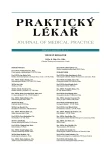Biological therapy in oncology (I)
Authors:
P. Králíčková; J. Krejsek; I. Krčmová
Authors‘ workplace:
ÚSTAV KLINICKÉ IMUNOLOGIE A ALERGOLOGIE
; Fakultní nemocnice Hradec Králové
Published in:
Prakt. Lék. 2011; 91(4): 189-192
Category:
Reviews
Overview
The incidence of cancer increased substantially during the 20th century. Cancer is the second leading cause of mortality in developed countries. Partially effective therapeutic approaches and medicamentous treatments:
– irradiation,
– chemotherapy, and
– later biological therapy
were developed in the second half of the last century to help combat this cancer epidemic. We review the efficacy of biological therapy based on cell-mediated immunity (BCG vaccination, cancer vaccination, adoptive immunotherapy).
The aim of biological therapy is to optimally target the tumorigenesis process and to reverse it with minimal side effects.
Key words:
biological treatment, bacterial adjuvants, cancer vaccination, adoptive immunotherapy.
Sources
1. Aarntzen, E.H., Fidor, C.G., Adema, G.J. et al. Dendritic cell vaccination and immune monitoring. Cancer Immunol. Immunother. 2008, 57 (15), p. 1559-1568.
2. Ballestrero, A., Boy, D., Moran, E. et al. Immunotherapy with dendritic cells for cancer. Adv. Drug. Deliv. Rev. 2008, 60 (2), p. 173-183.
3. Berntsen, A., Geertsen, P.F., Svane, I.M. Therapeutic dendritic cell vaccination of patients with renal cell carcinoma. Eur. Urol. 2006, 50, p. 34-43.
4. Bubeník, J., Mikyšková, R., Vonka, V. et al. Interleukin-2 and dendritic cells as adjuvans for surgical therapy of tumours associated with human papillomavirus type 16. Vaccine 2003, 21(9-10), p. 891-896.
5. Escudier, B., Farace, F., Angevin, E. et al. Immunotherapy with IL-2 and lymphokine-activated natural killer cells: Improvement of clinical responses in metastatic renal cell carcinoma patients previously treated with IL-2. Eur. J. Cancer 1994, 30(8), p. 1078-1083.
6. Grange, J.M., Bottaso, O., Stanford, C.A., Stanford, J.L. The use of mycobacterial adjuvants-based agents for immunotherapy of cancer. Vaccine 2008, 26(39), p. 4984-4990.
7. Gregoire, M., Ligeza-Poisson, C., Juge-Morineau, N., Spisek, R. Anti-cancer therapy using dendritic cells and apoptotic tumour cells: pre-clinical data in human mesothelioma and acute myloid leukemia. Vaccine 2003, 21(7-8), p. 791-794.
8. Gross, S., Walden, P. Immunosuppressive mechanisms in human tumors: Why we still cannot cure cancer. Immunol. Lett. 2008, 116(1), p. 7-14.
9. Guiducci, A.P., Vicari, S., Sangaletti, R., et al. Redirecting in vivo elicited tumor infiltrating macrophages and DC towards tumor rejection. Cancer Res. 2005, 65, p. 3437-3446.
10. Hořejší, V., Bartůňková, J. Základy imunologie. 3. vydání, Praha: Triton, 2005, s. 40, 106-118, 128-144, 174-182.
11. Huang, B., Mao, C.H.P., Peng, S. et al. Intradermal administration of DNA vaccines combining a strategy to bypass antigen processing with a strategy to prolong dendritic cell survival enhances DNA vaccine potency. Vaccine 2007, 25(45), p. 7824-7831.
12. Kiessling, A., Fuessel, S. Advances in specific immunotherapy for prostate cancer. Eur. Urol. 2008, 53(4), p. 694-708.
13. Kikly, K., Liu, L., Na, S., Sedgwick, J. D. The IL-23/Th17 axis: therapeutic targets for autoimmune inflammation. Curr. Opin. Immunol. 2006, 18(6), p. 670-75.
14. Krejsek, J., Kopecký, O. Klinická imunologie. 1.vydání, Hradec Králové: Nucleus, 2004, s. 105-109, 197-209, 226-227, 541-566, 802-804 .
15. Lohr, J., Knoechel, B., Caretto, D. et al. Balance of Th1 and Th17 effector and peripheral regulatory T cells. Microb. Infect. 2009, 11, p. 589-593.
16. deMartel, C., Franceschi, S. Infections and cancer: established associations and new hypotheses. Crit. Rev. Oncol. Hematol. 2009, 70(3), p. 183-194.
17. Nencoini, A., Grunebach, F., Schmidt, S.M. et al. The use of dendritic cells in cancer immunotherapy. Crit. Rev. Oncol. Hematol. 2008, 65(3), p. 191-199.
18. Ochs, H.D., Oukka, M., Torgerson, T.R. et al. Th17 cells and regulatory T cells in primary immunodeficiency diseases. Clin. Rev. Allergy Immunol. 2009, 123(5), p. 977-983.
19. Pejawar-Gaddy, S., Finn, O.J. Cancer vaccines: Accomplishments and challenges. Crit. Rev. Oncol. Hematol. 2008, 67(2), p. 93-102.
20. Perrone, G., Ruffini, P.A., Catalano, V. et al. Intratumoural FOXP3-positive regulatory T cells are associated with adverse prognosis in radically resected gastric cancer. Eur. J. Cancer 2008, 44(13), p. 1875-1882.
21. Prenen, H., Gil, T., Awada, A. New therapeutic developments in renal cell cancer. Crit. Rev. Oncol. Hematol. 2009, 69(1), p. 56-63.
22. Sallusto, F., Lanzavecchia, A. Human Th17 cells in infection and autoimmunity. Microb. Infection 2009, 11, p. 620-624.
23. Sica, A., Allavena, P., Mantovani, A. Cancer related inflammation: The macrophage connection. Cancer Lett. 2008, 267(2), p. 204-215.
24. Suckow, M.A., Wolter, W.R., Sailes, V.T. Inhibition of prostate cancer metastasis by administration od tissue vaccine. Clin. Exp. Metastasis 2008, 25(8), p. 913-918.
25. Toloza, E.M., Tyler, D., Yang, Y. How does the immune system attack cancer? Curr. Probl. Surg. 2004, 41(1), p. 1-132.
26. Urdaneta, G., Solsona, E., Palou, J. Intravesical chemotherapy and BCG for the treatment of bladder cancer: evidence and opinion. Eur. Urol. 2008 (Suppl), p. 542-547.
27. Weide, B., Garbe, C., Rammenseem H.G. et al. Plasmid DNA - and messenger RNA-based anticancer vaccination. Immunol. Lett. 2008, 115(1), p. 33-42.
28. Ziegler, S.F., Bruckner, J.H. FOXP3 and the regulation of Treg/Th17 differentiation. Microb. Infection 2009, 11, p. 594-598.
29. Zhang, B., Rong, G., Wei, H. et al. The prevalence of Th17 cells in patients with gastric cancer. Biochem. Biophys. Res. Commun. 2008, 374(3), p. 533-537.
Labels
General practitioner for children and adolescents General practitioner for adultsArticle was published in
General Practitioner

2011 Issue 4
Most read in this issue
- Antihypertensives, antibiotics, analgesics, and other drugs frequently used in pregnancy
- Tracheal rupture after endotracheal intubation
-
Basics of social cognitive and affective neuroscience.
IV. Psychopathy - Positive emotions, laughter, kindness and clinical medicine
